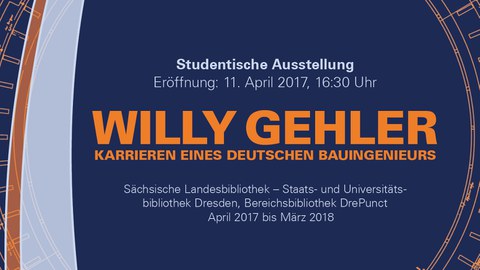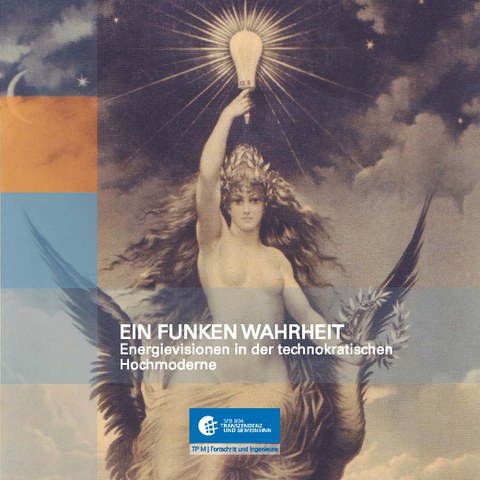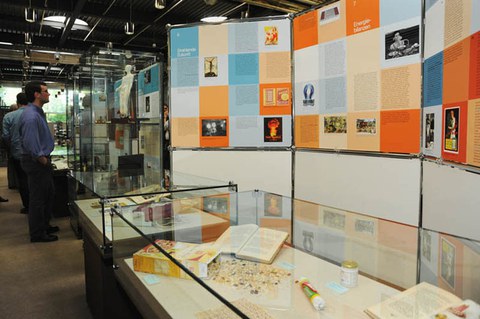Student exhibitions
Table of contents
In recent years, the historians of technology at TU Dresden have regularly designed exhibitions together with students in practical seminars and have also realized them in cooperation with the SLUB Dresden. Here you can find a selection of the latest projects.
Willy Gehler. Careers of a German civil engineer
Student exhibition at the SLUB Dresden, April 2017 to March 2018
Uwe Fraunholz, Hagen Schönrich, Oliver Steinbock, Clemens Milker and Philipp Pfennig
Accompanying brochure about Qucosa available
Today, reinforced concrete is an omnipresent building material that combines the compressive strength of concrete with the tensile strength of steel. Gray concrete surfaces encasing hidden metal cores shape large parts of the human technotope and are at best rejected for aesthetic reasons. Functionality, on the other hand, is no longer in question. One hundred years ago, it was by no means a matter of course to construct buildings in reinforced concrete. Rather, it was left to a small avant-garde of civil engineers to lay the foundations for the reinforced concrete construction method that is firmly established today. Students from a practical seminar at the Institute of History have designed an exhibition dedicated to one of them: Willy Gehler (1876-1953), professor at Dresden University of Technology. He studied, taught and researched here and also left his mark on the city of Dresden with his buildings.
The exhibition was opened as part of the workshop "Willy Gehler - Versuch einer Einordnung" on April 11, 2017 at 4:30 pm in the Saxon State and University Library Dresden, DrePunct Departmental Library. It is based on the results of the research project "Willy Gehler (1876-1953) - Top-level research, political self-mobilization and historical reception of an important civil engineer and university lecturer in the 'century of extremes'".
- Oliver Steinbock, Manfred Curbach and Thomas Hänseroth: Willy Gehler - an attempt at classification. Workshop and exhibition on the life and work of a controversial university lecturer and reinforced concrete pioneer, in: Beton- und Stahlbetonbau 112 (2017), H. 8, pp. 556-559.
- Manfred Curbach, Oliver Steinbock and Thomas Hänseroth: Willy Gehler - Versuch einer Einordnung. Proceedings of the workshop in Dresden on April 11, 2017,
Dresden 2018.
The project is funded by the German Research Foundation and is dedicated to researching Willy Gehler's scientific achievements in the field of reinforced concrete and his life in four political systems. Scientists from the Institute of Concrete Structures and the Chair of History of Technology and Science of Technology at TU Dresden are jointly researching Gehler's life. On the one hand, his life is of scientific interest, as it is closely linked to the pioneering deeds of reinforced concrete in Germany. On the other hand, his example can be used to examine the work of technical scientists in four different political systems, as the protagonist was active in the German Empire, the Weimar Republic, the National Socialist era and the GDR. The study of Willy Gehler is therefore suitable for pointing out continuities and breaks in the biographies of bourgeois elites and for cutting exemplary paths in the history of construction, higher education and science in the first half of the 20th century.
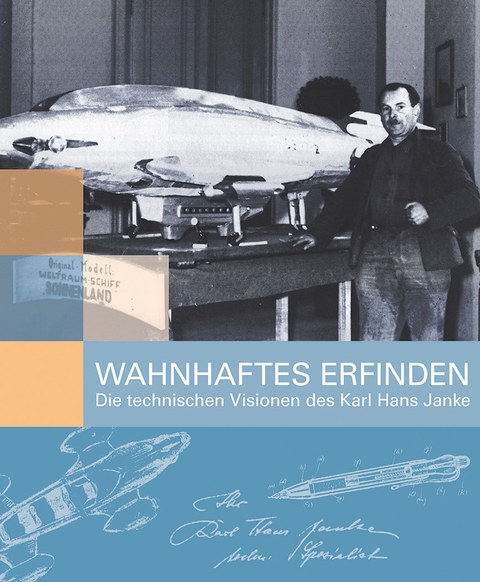
Poster zur Ausstellungseröffnung
Delusional invention. The technical visions of Karl Hans Janke
Student exhibition at the SLUB Dresden, Nov. 2014 to Oct. 2015
Uwe Fraunholz and Hagen Schönrich with the collaboration of Betty Baumann, Matthias Dörr, Sascha König-Apel and Danilo Röntsch

Ausstellungeröffnung im November 2014: Uwe Fraunholz stellt die Person Janke näher vor
The Second World War only shattered the technocratic high modernism's sense of technological progress for a short time - the conviction that social problems could be solved by technical means quickly gained ground again. High-flying visions of space travel, the atom and automation revitalized the popularization of future technology from the 1950s onwards. Even the Hubertusburg State Psychiatric Hospital was not unaffected by these trends: Karl Hans Janke (1909-1988) designed thousands of vehicles and airplanes, spaceships and engines, energy concepts and electrical devices in the almost four decades he spent in Wermsdorf. The talented draughtsman and designer created numerous models and worked on an alternative history of human development, which he embedded in his cosmology. To this end, he gave lectures and corresponded with companies and government agencies.

Gemeinsame Exkursion zur Dauerstellung nach Wermsdorf
In addition to his fantastic drawings, Karl Hans Janke left behind a moving legacy: seemingly selflessly, he placed himself at the service of the society that had segregated him. Is this mere prudent altruism? Was this a sick man craving the recognition he had been denied all his life? Be that as it may, Karl Hans Janke paradigmatically embodies the engineers' assertion of altruism, which lent credibility to the promises of a technologized future and, in mutual entanglement with these promises, shaped the era of high modernism.

Ausstellungseröffnung im November 2014: Hagen Schönrich erläutert Jankes Beteiligung am sozialistischen Aufbauprojekt
After his death, Janke's graphic visions were initially forgotten. In the mid-1990s, the Saxon performance duo "norton.commander.productions" first became aware of Janke due to the extensive correspondence that had survived, before the new head physician of the Hubertusburg psychiatric ward, Dr. Peter Grampp, rediscovered his drawings in an attic in 2000. Thousands of drawings were stored there, folded to postcard size to save space, in suitcases and fruit crates. Grampp recognized their artistic value and ensured that Karl Hans Janke's work has been presented in various exhibitions since 2001, including internationally. Today, the Association for the Promotion of the Psychiatric Department of the Hubertusburg Clinics is entrusted with the processing and administration of the estate. The association has a permanent exhibition worth seeing on the grounds of the institution in Wermsdorf. The majority of Janke's drawings are also available online. In its Janke archive, the Deutsche Fotothek keeps around 3500 digital copies of Janke's drawings and produces high-quality prints from them on request.
- Accompanying brochure available via Qucosa
- Link to the permanent exhibition in Wermsdorf
- Wermsdorf atomic bicycle makes TU Dresden students shine, in: Oschatzer Allgemeine Zeitung v. 02.12.2014
- The legacy of a genius, in: Sächsische Zeitung v. 21.09.2015
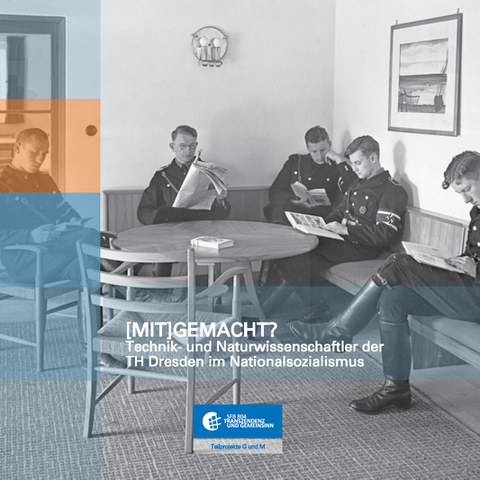
Cover der Ausstellungsbroschüre
[Made with? Technicians and scientists at the TH Dresden under National Socialism
Student exhibition at the SLUB Dresden, Oct. 2012 to Nov. 2013
Uwe Fraunholz and Swen Steinberg with the collaboration of Stefan Beckert, Florian Eichkorn, Ulrike Marlow, Stefan Weise and Daniel Wendorf
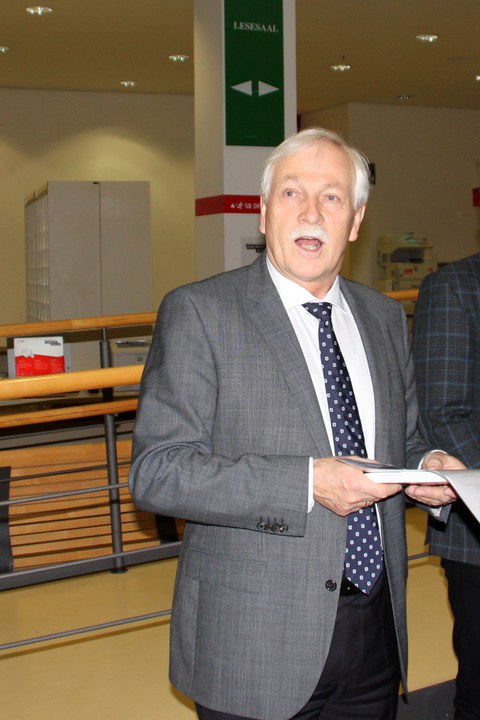
Ausstellungseröffnung durch Thomas Bürger, Generaldirektor der SLUB
The realization of the extensive goals of National Socialist rule required the commitment of capable scientists and technicians from the very beginning. The transfer of power to the National Socialists therefore also led to far-reaching cuts at Dresden University of Technology. Initially, those who were not allowed to belong to the desired "national community" for racist reasons or who were politically unpopular were expelled. The academic authorities were able to rely on the applause of many students, who revealed a frightening affinity with National Socialism early on. However, the vast majority of academics remained in their positions. They had a certain amount of leeway to react to the constraints and mobilization strategies of Nazi technology and science policy. While a minority remained relatively resistant, the majority of engineers and scientists willingly placed themselves at the service of the "national community" and warfare, thus ensuring the apparent legitimacy and stability of the dictatorship. In contrast, there were hardly any acts of resistance: Too many were prepared to relate their public spirit to an exclusive "people's community" from then on, too few felt connected to the traditional ethos of the sciences, which at least pretend to be altruistically in the service of humanity.
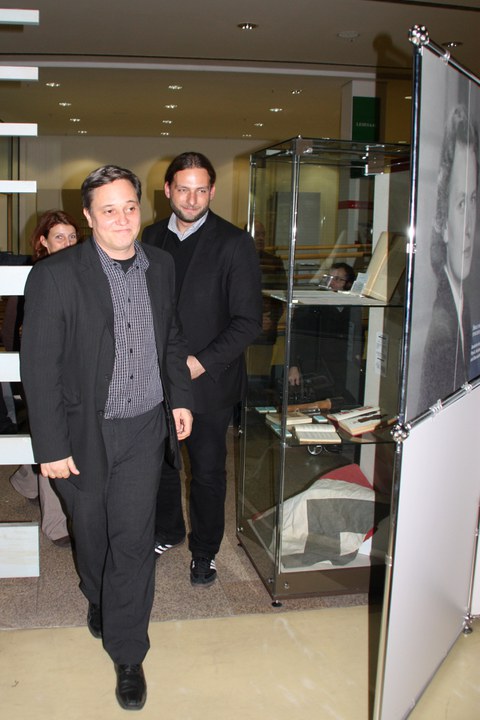
Uwe Fraunholz und Swen Steinberg stellen zur Eröffnung ihr Ausstellungskonzept vor
A look at the military-economic functionalization of the TH Dresden in the Nazi state makes it clear that the dictum found in older research about the misuse of science under National Socialism can hardly be upheld. Rather, science and politics were "resources for each other" (Mitchell Ash). Some technicians and scientists at the TH Dresden took advantage of the new career opportunities as part of their self-mobilization and were responsible for some groundbreaking innovations. Others conducted research away from the world market, increasingly cut off from international cooperation and developed second-rate products from unsuitable resources at immense expense. In conjunction with the expulsion or physical destruction of part of the scientific and technological elite, this meant that Germany was in danger of losing out in key areas of the modernization race after the Second World War. It is therefore hardly surprising that involvement in the National Socialist war economy was hardly a career obstacle in either German state. Skilled technicians and engineers were simply needed for reconstruction. Scientists who had been committed to the success of the war effort during the Nazi era were therefore reappointed to full professorships in both East and West, and at the TH Dresden one or two post-war rectors were recruited from this group.
In the following, we will take a look at the behavior that academics showed or had to show at the TH Dresden from the spring of 1933: technical and natural scientists refused to accept the new system or were excluded from it. Others were already supporters of the National Socialists before 1933 or adapted to it - the majority were able to successfully advance their careers. Exemplary biographies are selected and presented in a targeted manner in order to outline the spectrum of possible behavior. On the one hand, this provides an insight into biographies that have not been told before, or only partially. On the other hand, it highlights the variety of interdependencies that existed between science, politics and business in National Socialist Germany - including at the TH Dresden.
- Accompanying brochure available via Qucosa
- Protected by reliable followers, in: Dresdner Universitätsjournal 20 (2012)
- A look into the past, in: ad-rem v. 09.01.2013
- Still relevant, in: Sächsische Zeitung v. 10.11.2014
A spark of truth: visions of energy in technocratic high modernism
Student exhibition at the SLUB Dresden, June 2011 to Oct. 2012
Uwe Fraunholz and Sebastian Beese with the collaboration of Christoph Geiser, Michael Kuhl, Ralf Pulla, Teresa Schergaut, Anna Lotta Seifert and Oliver Zauritz
Visions of the future that are essentially related to technology are an important medium of social discourse on technology. Technical visions and utopias are linked to contemporary models, as they carry specific expectations of salvation, promises and imaginary worlds of the respective present. Collective visions of the future may tell us little about future realities, but we can learn a lot about past societies.

Thomas Bürger, Generaldirektor der SLUB Dresden, an der eigens für die Ausstellung konzipierten Medienstation
One of the defining phenomena of "technocratic high modernity", which can be roughly narrowed down to the years between 1880 and 1970, is the scientistic promise of technological progress. Ideas of the future charged with technology and a belief in science entered into a close liaison during this period. For example, the popularity and semantics of the science fiction genre, which emerged at the end of the 19th century, point to the importance of the scientism typical of the time for the construction of powerful utopias. Technical visions popularized the idea of a better world shaped by new technology. They had the effect of opening up the technologized future as a resource for experiencing transcendence. Linked to this was an assertion of altruism on the part of engineers, which shaped the era in a reciprocal interweaving with the promises of a technologized future. High modernism was essentially characterized by technical visions and utopias, by surpluses of hope drawn from the technical changes of the respective present, as well as by the idea of a better world to be brought about by new technology.
At the same time, the history of Western industrialized nations and consumer societies is inextricably linked to the history of their energy consumption. Long periods of the 20th century were characterized by a belief in modernization and technological progress. This in turn required a constant mobilization of energy. The exploitation of natural resources not only appeared to be the engine of the future, but also became a symbol of progress itself. Many visions were linked to this: Scientists and writers dreamed of inexhaustible energy sources, engineers planned seemingly utopian large-scale projects. The promise of electrification or the possibilities of small-scale motorization also evoked hopes that could hardly be realized.
The student exhibition Ein Funken Wahrheit - Energievisionen in der technokratischen Hochmoderne sheds light on the ultra-modern hunger for energy and on visionary proposals on how to satisfy it. Based on the spread of electricity and the realization of the need to save energy, which has not only been gaining ground since the 1970s, mega-plans to ensure a sustainable energy basis are examined. Limitless hopes were once associated with nuclear energy and are still associated with fusion energy today. The search for the perpetual motion machine, the dream of generating energy from nothing, on the other hand, is older than high modernity. It continues to be dreamed of by the propagandists of free energy. This scene also deals with questions of energizing the human body, which forms a second focus of the exhibition: Voltages are applied to bodies, electrical devices release tension. Radiant energy is intended to release human energy, and energy requirements must be met through the supply of calories. Despite this exuberant utopian elan, the inclined visitor may discover a spark of truth in the future designs presented.

